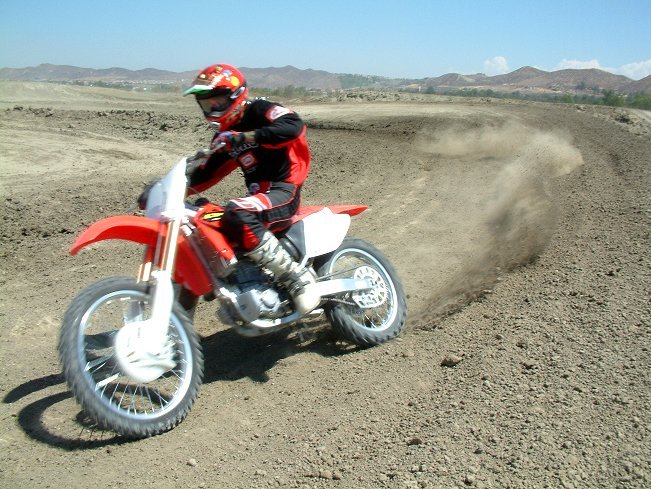
Mike Metzger Was A Blur All Day On The 2003 CRF450R
To say that the world of motocross race bikes is competitive for manufacturers is a gross understatement. Significant changes to your motocross machines each and every year is now the rule, not the exception. It is a rule that Honda has followed with the 2003 CRF450R and 2003 CR250R.
With Editor Dirck Edge and Freestyler/Pro Supercross Rider Mike Metzger at the controls, MD had a chance to sample the two big motocross bikes from Big Red for 2003. Before getting to our initial impressions of these bikes (and they are initial impressions — based on just a half day of riding at Lake Elsinore Motocross Park), let’s talk about some of the technical changes this model year.
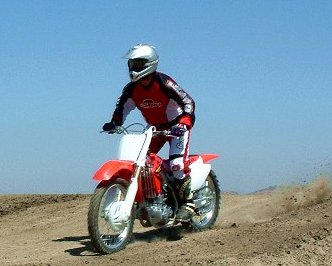
The 2002 CRF450R was Honda’s long-awaited response to Yamaha’s YZ426F. The aluminum-framed wonder from Honda broke all the rules with regard to weight in the open four-stroke motocross class, checking in at approximately 232 pounds wet (with no fuel). On top of this, the 450 had a smooth, powerful motor, and a lightweight feel in the air and in the corners. If it had a flaw, it was a somewhat raked-out feel to the front end, and a tendency to push in turns. Something that was addressed by a number of aftermarket manufacturers with triple clamps offering reduced off-set.

2003 CR250R
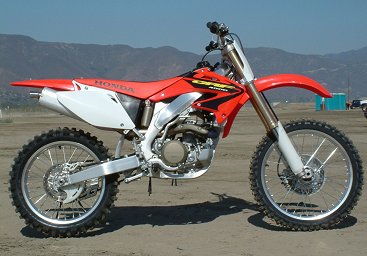
2003 CRF450R
For 2003, Honda addressed the handling issues by making a number of changes to the CRF450R. These chassis changes include a new shock linkage that raises the swingarm pivot 7mm — creating a steeper 27 degree steering head angle, and placing more weight on the front wheel. Contributing to the increased weight over the front end of the machine is a 10mm taller seat and a handlebar 3mm forward of last year’s position.
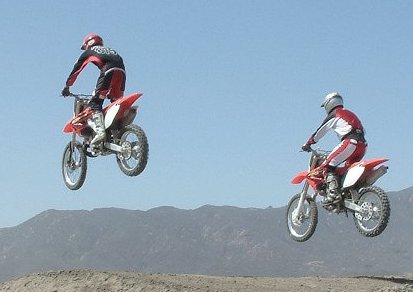
The four-stroke engine received attention, as well. A new cam shaft, shorter muffler, brand-new airbox and air cleaner all contribute to increased power, according to Honda. Together with new ignition timing and carburetor jetting, Honda claims these changes add up to horsepower and torque peaks 500 rpm lower than last year’s bike, with a significant boost in low-end power.
The CR250R has its share of significant changes, as well. In the second year of a new chassis design, the 250 has several engine changes this year, including new cylinder porting, a new, larger eight-petal reed valve (with carbon fiber reeds), straighter intake air boot, reshaped exhaust valve, new ignition timing and a new pipe. Honda claims these changes add up to roughly the same peak horsepower, but greater low-end power, and increased over-rev.
The 250 also has new suspension settings designed to create a more plush, yet controlled, feel front and rear.
Riding the new 450 shows that Honda’s chassis tweaks really make the front end bite in corners this year (we failed to mention a stiffer rear spring — another change that tends to shift more weight over the front end). Still with good straight-line stability, the CRF450R corners very quickly — feeling like a light two-stroke in the process.

The engine changes are very noticeable, as well. Still without much of a hit, the CRF450R pulls a bit harder off the bottom and allows you to feel comfortable carrying third gear through relatively slow corners. Indeed, we could ride the whole track in third gear without much trouble.
Like last year, the CRF450R impresses with how easy it is to ride. Metz owns a 2002 CR250R, but we couldn’t pull him off the new 450. Metz raved about the power and the handling, and pounded laps like he had been training for the Outdoor Nationals (he hasn’t). Metz concluded the 2003 CRF450R is a great bike for riders of all skill levels due to its light weight and user friendly, but powerful motor. I had to agree.
Lake Elsinore is not the best track to test suspension, and we will have to reserve judgment on both the 450 and the 250 on this count until we can ride in rougher, choppier conditions. At Elsinore, the 450 felt very good, although the 250 felt a bit plusher in the fork. Both bikes felt very balanced front-to-rear, with the heavier spring on the 450’s shock appreciated by our heavier tester (that’s me, in case you hadn’t guessed).
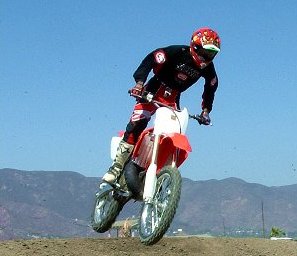
When I first rode the 250, I really couldn’t believe how plush the fork felt. It soaked up chop (what little chop we could find at Elsinore) superbly, but refused to bottom on big landings. The lighter, but much faster Metzger felt the fork was a bit too soft on the 250, but Metz could clearly appreciate an increase in bottom end power versus his 2002 model. Neither I nor Metz really tested the over-rev capabilities of the 250 on the tight, Elsinore tracks. The 250 did have a slight stumble off idle before pulling into a clean, low-end and mid-range rush. Once on the track, you would rarely notice this jetting glitch down low. I have to mention, however, that Honda was not running stock jetting on our 250. I will get the revised jetting we were running, and post that information here, later.
Overall, the 250 also proved to be smooth and easy-to-ride, without any sudden surge of power — just one, long, smooth pull that starts a bit lower this year.
We will have more details, with more technical information and technical photos, when we get to test the bikes on a longer-term basis a bit later. For now, the Honda CRF450R and CR250R look like refined motocross packages that contain significant improvements over the 2002 models.

Dirck Tries To Wrestle The CRF450R From Metzger





